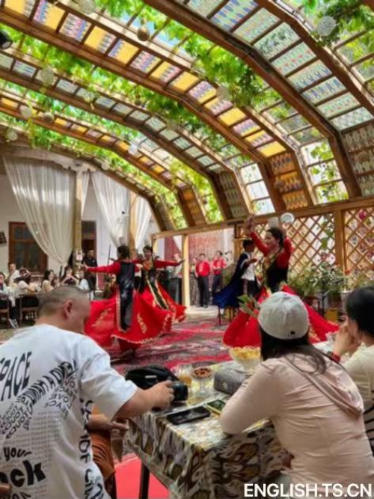Our travels through Xinjiang were filled with music and dance. From the lively sounds of Uygur music that filled the bus, dance parties on the street and in restaurants, to elaborate costumed performances, it seemed like all our destinations swiftly broke out into enthusiastic choreography.

The styles of music and dance reflected Xinjiang’s cultural diversity, with dancers and musicians of various ethnic backgrounds performing an array of styles. We saw Russian folk dancers and toe tapping accordion players, but most commonly we watched dancers performing Senam, a dance and music style widespread among Uygur people. From twisting and flowing skirts, intricate flicks of the wrist and isolations of the neck, to grand shows balancing cups and pots of tea, each performance was filled with energy and talent and gave us a small glimpse into some of the cultural traditions of Xinjiang.
On many occasions we were invited to join the dancers on stage to learn basic movements and share in the revelry. Our group of students from around the world came together to join in the energy of the crowd as we clapped along, called out in awe, and took in the spectacle before us. We were given an active and participatory view of Xinjiang’s cultural dance traditions.
Music and dance have become linked to the image of Xinjiang that is being promulgated in tourism, advertisements, and on social media. The “Xinjiang Dance” trend across Chinese social media in 2023 reflects the ways in which these traditions have been mobilized in shifting perceptions of Xinjiang and in promoting tourism. Amateur dancers took to video platforms like Douyin and Xiaohongshu to take part in the craze, and “Xinjiang dance” took off as a nationwide trend attracting over 1.6 billion views. Interest in learning these dance styles peaked, and in response, the autonomous region’s cultural center launched online Xinjiang dance classes, and dispatched Xinjiang dance ambassadors to cities around China to teach eager crowds.
Travelers to Xinjiang flocked to city squares to experience “Xinjiang dance parties,” where locals would invite tourists into the crowd for informal group dance sessions. Visitors would post videos online of them participating in these dances, often donning Xinjiang style dance costumes in a performance of their imaginings of cultural tradition.
Mira Vance is from the United States and is a master’s student at Peking University.
Producer: Xiao Chunfei
Supervisors: Ding Tao and Jie Wenjin
Planners: Jie Wenjin and Cheng Li
Reviewers: Cheng Li and Hou Weili
Editors: Gvlzar Mijit









